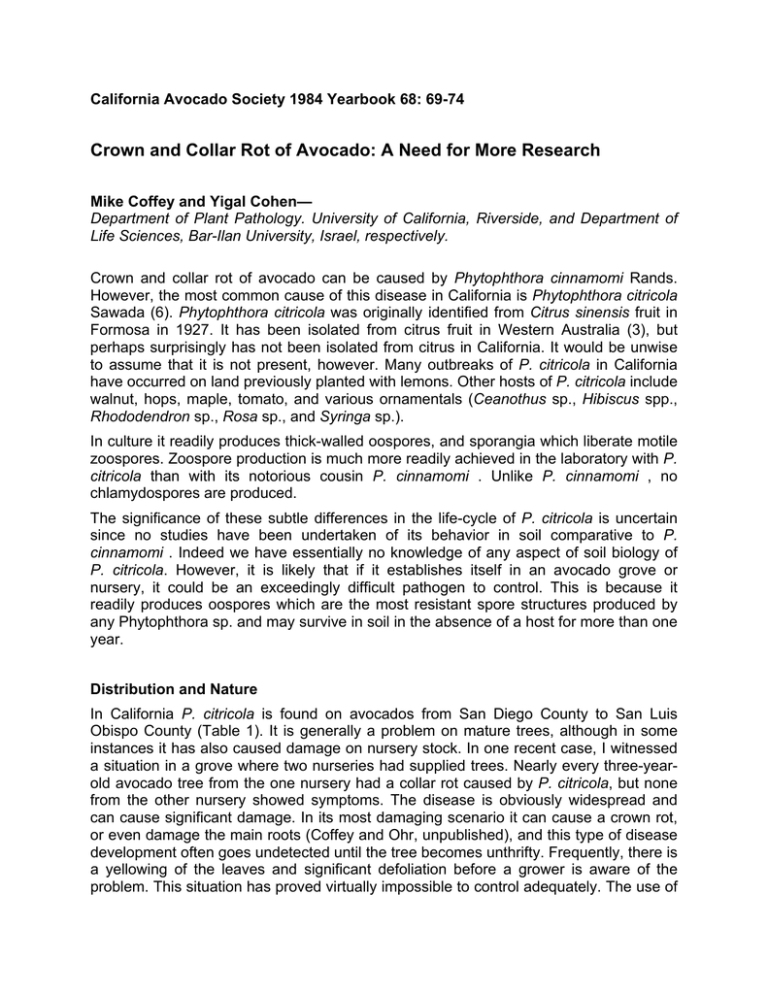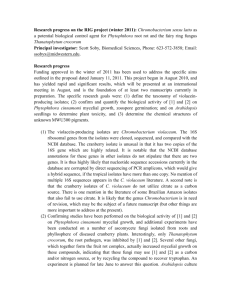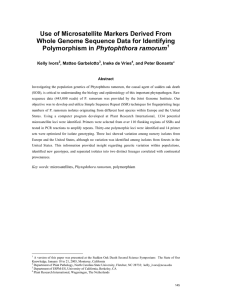Crown and Collar Rot of Avocado: A Need for More...
advertisement

California Avocado Society 1984 Yearbook 68: 69-74 Crown and Collar Rot of Avocado: A Need for More Research Mike Coffey and Yigal Cohen— Department of Plant Pathology. University of California, Riverside, and Department of Life Sciences, Bar-Ilan University, Israel, respectively. Crown and collar rot of avocado can be caused by Phytophthora cinnamomi Rands. However, the most common cause of this disease in California is Phytophthora citricola Sawada (6). Phytophthora citricola was originally identified from Citrus sinensis fruit in Formosa in 1927. It has been isolated from citrus fruit in Western Australia (3), but perhaps surprisingly has not been isolated from citrus in California. It would be unwise to assume that it is not present, however. Many outbreaks of P. citricola in California have occurred on land previously planted with lemons. Other hosts of P. citricola include walnut, hops, maple, tomato, and various ornamentals (Ceanothus sp., Hibiscus spp., Rhododendron sp., Rosa sp., and Syringa sp.). In culture it readily produces thick-walled oospores, and sporangia which liberate motile zoospores. Zoospore production is much more readily achieved in the laboratory with P. citricola than with its notorious cousin P. cinnamomi . Unlike P. cinnamomi , no chlamydospores are produced. The significance of these subtle differences in the life-cycle of P. citricola is uncertain since no studies have been undertaken of its behavior in soil comparative to P. cinnamomi . Indeed we have essentially no knowledge of any aspect of soil biology of P. citricola. However, it is likely that if it establishes itself in an avocado grove or nursery, it could be an exceedingly difficult pathogen to control. This is because it readily produces oospores which are the most resistant spore structures produced by any Phytophthora sp. and may survive in soil in the absence of a host for more than one year. Distribution and Nature In California P. citricola is found on avocados from San Diego County to San Luis Obispo County (Table 1). It is generally a problem on mature trees, although in some instances it has also caused damage on nursery stock. In one recent case, I witnessed a situation in a grove where two nurseries had supplied trees. Nearly every three-yearold avocado tree from the one nursery had a collar rot caused by P. citricola, but none from the other nursery showed symptoms. The disease is obviously widespread and can cause significant damage. In its most damaging scenario it can cause a crown rot, or even damage the main roots (Coffey and Ohr, unpublished), and this type of disease development often goes undetected until the tree becomes unthrifty. Frequently, there is a yellowing of the leaves and significant defoliation before a grower is aware of the problem. This situation has proved virtually impossible to control adequately. The use of chemicals such as Ridomil® which can suppress P. cinnamomi , do not help in the case of P. citricola crown rot. In experimental work Ridomil ® has proven useful, however, when sprayed at a concentration of about 5000 ppm on collar rot lesions. The lesion generally ceased to develop further and several months later the fungus was difficult to isolate from the diseased bark. Table 1. Geographical origin of some avocado isolates of Phytophthora citricola Sawada isolated in California. a The P designation indicates that the isolate is held in the Phytophthora culture collection at UCR. Judging from the large number of cases which have been reported to us where trees have been lost due to P. citricola, the disease must be having a significant impact on avocado production. As it becomes more established it will take an increasing toll since more and more land infested with P. citricola will be replanted with new nursery stock. Will these nursery trees also contract the disease? The answer is that we don't know! Research at UCR Research has begun at UCR on the problem. We have carried out preliminary experiments with avocados planted in soil artificially infested with P. citricola (Table 2). Surprisingly with some isolates tested as many as 80% of the feeder roots of Topa Topa seedlings became infected (Cohen and Coffey, unpublished). In the field P. citricola is often difficult to isolate directly from feeder roots, although it can usually be isolated from soil using Persea indica seedlings as a trap. We have made some preliminary investigations of the inherent biological variability among different isolates (Table 3). It was found that two isolates had high survivability in soil over a period of a month, two others were recovered at much lower levels, and three isolates did not survive at all (Cohen and Coffey, unpublished). Similarly in pathogenicity tests, different isolates had variable capacities to produce rots on the stems and roots of P. indica seedlings (Fig. 1). Table 2. Infectivity of Phytophthora citricola, isolate P1346, used as inoculum in UC mix against Persea americana cv. Topa Topa. a Measured during the last 4 wks of the experimental period (8 weeks). b After 3 days of incubation at 70 C. c From 20 feeder root segments per plant on PARPH selective medium at 8 wks after inoculation. Table 3. Survivability of Phytophthora citricola in UC mix ( ~ 10% moisture) after one month of storage at ~ 25 C and inoculum potential of stored soil. Studies on the protein patterns of different isolates have confirmed that all have patterns typical of P. citricola (Khew, Coffey and Zentmyer, unpublished). However, different isolates possess different types of some enzymes (e.g., esterase). How significant is all this biological variability in terms of the potential for causing disease? Hopefully, more research will provide the answer. Control Strategies Attempts at control of crown rot of avocado have so far failed. Currently, we are investigating the possibility that injecting trees with a phloem-mobile fungicide such as Aliette ® may help. With root rot caused by P. cinnamomi the earlier a chemical treatment is applied, the more dramatic the results. Unfortunately, in the case of P. citricola the disease frequently goes undetected until actual decline is occurring. In such situations the only real hope is to begin protecting trees in the grove which have yet to display significant stress symptoms. Our research with fungicides is directed toward this aim. Fig. 1. Canker development incited by Phytophthora citricola on stems and roots of Persea indica. Bare-rooted plants with ~ 10-cm-long primary roots and 11-cm-long stems were laid in aluminum trays and inoculated with a 5-µl droplet of zoospore suspension in the middle of the stem, or with ten 3-µl droplets of zoospore suspension along the main root. Trays were placed in moist plastic bags and incubated at room temperature (~ 24 C). Zoospore concentration was ~ 3.3 x 105/ml for all isolates, except for 1287 which was ~ 1.1 x 105/ml (Coffey and Cohen, unpublished data). One of the problems with P. citricola is its irregular development in a grove. This makes the designing of fungicide trials very difficult. In practice we choose trees which are virtually symptomless and hope that they possess similar propensities for disease development. In the laboratory, work with the two systemic fungicides Ridomil® and Aliette® has revealed several interesting features of their in vitro properties. A comparison of the efficacy of Ridomil ® against isolates of P. cinnamomi (root rot) and P. citricola (crown rot) demonstrated that inhibitory levels were 0.07-0.14 ppm and 1.2-4.6 ppm, respectively (2). With Aliette®, or more correctly its breakdown product in plants which is phosphorous acid, 5-10 ppm caused 50% inhibition of growth of both P. citricola. and P. cinnamomi (1). This level of inhibition by a low concentration of Aliette® or phosphorous acid also occurred when plants were inoculated with P. citricola (4). Theoretically Aliette ® should be a good choice for control of P. citricola, since it has phloem-mobile properties and so can move down to the roots when applied above ground. However, we have yet to demonstrate any good efficacy against crown rot under field conditions. Finally, we need to examine the potential of our rootstocks, developed for tolerance to P. cinnamomi, to also resist P. citricola. We established two small field trials this year. Unfortunately, as we have yet to determine how P. citricola attacks avocado under natural conditions, this is a largely hit and miss affair. Our only premise is that the previous trees in the two groves did go out with crown or collar rot. One of the possible options here is to artificially inoculate the soil adjacent to the tree trunk with P. citricola. As you can imagine many growers have some aversion to this technique! Summary We were encouraged this year by the first research support for the project. It is a hopeful sign that there is a growing awareness of the problem. Recently, Mircetich and Matheson (5) reported that among ten different Phytophthora spp. pathogenic to walnut, P. citricola and P. cinnamomi were by far the most destructive causing crown and root rot, and presented the most serious threat to that industry in California. Further studies should be made of the pathogenic potential of a wider range of P. citricola isolates on avocado. The possibility that P. citricola is being introduced on other hosts such as ornamentals should be examined. In the final analysis we need to develop a costeffective control program for P. citricola of the type currently underway for P. cinnamomi There is a critical need for more research on this problem. Literature Cited: Coffey, M.D. and L.A. Bower. 1984. In vitro variability among isolates of eight Phytophthora species in response to phosphorous acid. Phytopathology 74: 738-742. Coffey, M.D., L. J. Klure and L.A. Bower. 1984. Variability in sensitivity to metalaxyl of isolates of Phytophthora cinnamomi and Phytophthora citricola. Phytopathology 74:417-422. Doepel, R. F. 1966. Phytophthora species on citrus in Western Australia. Plant Disease Reporter 50: 495-496. Fenn, M.E. and M.D. Coffey. 1984. Studies on the in vitro and in vivo antifungal activity of fosetyl-Al and phosphorous acid. Phytopathology 74: 606-611. Mircetich, S.M. and M.E. Matheson. 1983. Phytophthora root and crown rot of walnut trees. Phytopathology 73: 1481-1488. Zentmyer, G.A., L. Jefferson and C. J. Hickman. 1973. Another species of Phytophthora on avocado in California. Calif. Avocado Society Yearbook 125-129.

